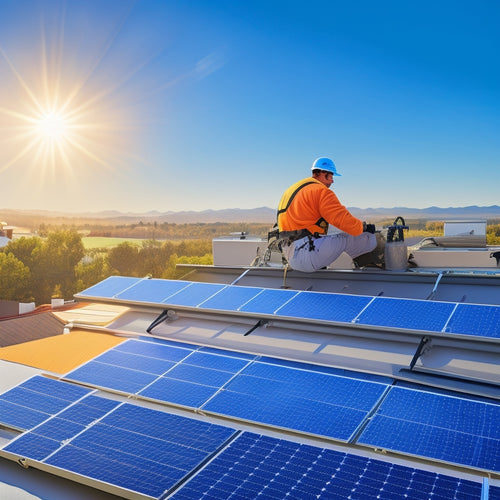
10 Best Ways to Size Your Home's Panel System
Share
To size your home's panel system accurately, start by determining your energy requirements through an energy audit and load calculation. Assess your roof's solar potential by analyzing its orientation, size, and shading. Establish a realistic budget and research financing options. Evaluate your energy efficiency by identifying areas of inefficiency and optimize your system accordingly. Verify compliance with local building codes and permits. Identify shade and obstructions that may impact your system's performance. Research local incentives and rebates, and analyze your energy consumption patterns to determine the right system size. You're on the path to maximizing your energy savings - now learn how to fine-tune your system for peak performance.
Key Takeaways
• Conduct an energy audit and load calculation to determine your home's energy requirements and optimize system size.
• Assess your roof's solar potential by analyzing orientation, size, and shading to ensure optimal panel placement.
• Establish a realistic budget and research financing options, incentives, and rebates to ensure an affordable and efficient system.
• Evaluate energy usage patterns and seasonal variations to accurately size your system and manage load efficiently.
• Measure your roof's sections and square footage, accounting for obstructions and geometry, to determine the ideal panel layout.
Calculate Your Energy Requirements
To determine the size of your home's panel system, you'll first need to calculate your energy requirements, which involves evaluating your energy usage patterns and identifying the total amount of wattage required to power your appliances and devices. This is important in ensuring your solar panel system can meet your energy demands.
Conducting an energy audit is an excellent way to start. It involves tracking your energy consumption over a specific period, usually a year. You'll need to gather past utility bills and identify areas of energy inefficiency. This will give you a clear picture of your energy usage patterns.
Next, perform a load calculation to determine the total wattage required to power your home. This involves identifying the wattage requirements of each appliance, lighting, and device. Be sure to include standby power consumption in your calculation. By doing so, you'll get an accurate estimate of your energy requirements.
This data will help you determine the correct size of your solar panel system, ensuring it can meet your energy needs efficiently.
Assess Your Roof's Solar Potential
You'll need to assess your roof's solar potential by evaluating its orientation, size, and shading obstacles to determine the best placement and size of your solar panel system. This includes analyzing your roof's anatomy, including its slope, pitch, and orientation. A south-facing roof with minimal shading is ideal for solar panels, as it receives the most direct sunlight throughout the day.
| Roof Orientation | Solar Potential |
|---|---|
| South-facing | High |
| East- or West-facing | Medium |
| North-facing | Low |
Consider the following factors to optimize your solar panel system:
** Solar orientation: A south-facing roof receives the most direct sunlight, making it ideal for solar panels.
**Shading obstacles: Trees, chimneys, and other obstructions can cast shadows on your roof, reducing its solar potential.
- Roof size and shape: A larger roof with a simple shape is more suitable for a solar panel system.
Determine Your Budget Constraints
Your budget plays a pivotal role in determining the size and type of solar panel system you can install. As you plan your solar panel system, it's important to establish a realistic budget to guarantee a successful and cost-effective installation. Financial planning is critical in determining the number of panels, type of equipment, and installation costs.
To optimize your budget, consider the following key factors:
-
System size and complexity: More extensive systems require more panels, increasing costs.
-
Panel quality and efficiency: High-efficiency panels may be more expensive, but they can generate more power per hour of sunlight.
-
Installation costs: Labor costs, permits, and inspections add to the overall expense.
-
Local incentives and rebates: Research available incentives to reduce your upfront costs.
-
Financing options: Explore financing options, such as loans or power purchase agreements, to fit your budget.
Evaluate Your Energy Efficiency
As you evaluate your energy efficiency, you'll need to assess your energy usage patterns, taking note of when and how you use energy-intensive appliances.
You'll also want to identify any gaps in your home's insulation, which can greatly impact your energy consumption.
Energy Usage Patterns
In order to optimize your home's panel system, understanding your energy usage patterns is essential. These patterns are influenced by various factors such as your daily routine, appliance efficiency, and seasonal changes. By evaluating your energy usage patterns, you can identify areas of inefficiency and make adjustments to maximize your energy production.
Here are some key factors to keep in mind:
-
Morning surge: Do you have a high energy demand in the morning when you're getting ready for work or school?
-
Afternoon peak: Are you using energy-intensive appliances like air conditioning or laundry machines during the hottest part of the day?
-
Evening usage: Do you have a high energy demand in the evening when you're cooking dinner or watching TV?
-
Seasonal variations: Do your energy needs change significantly between summer and winter?
-
Load management: Are there certain appliances or devices that consume a disproportionate amount of energy, and can you adjust your usage patterns to reduce peak demand?
Home Insulation Gaps
Now that you've assessed your energy usage patterns, it's time to identify potential energy losses in your home by evaluating insulation gaps, a critical component of energy efficiency.
You'll want to pinpoint areas where heat escapes or enters your home, as these air leaks can have a substantial impact on your energy consumption. Start by inspecting your attic, walls, and floors for gaps, cracks, and crevices. Check for worn-out or damaged insulation materials, such as fiberglass, cellulose, or spray foam, which can compromise their performance.
Look for signs of air leaks around windows, doors, electrical outlets, and switches. Don't forget to inspect your ductwork, as leaky ducts can account for up to 30% of energy losses. Use a lit candle or incense stick to detect air leaks, or hire a professional to conduct a blower door test.
Once you've identified the gaps, you can prioritize repairs and upgrades to optimize your home's insulation, reducing energy waste and saving you money on your utility bills.
Consider Local Building Codes
Your local building codes and ordinances dictate the minimum requirements for your home's panel system, so you'll need to familiarize yourself with these regulations to guarantee adherence. Failing to do so can result in costly rework, fines, or even project shutdowns. To avoid these issues, research your local building codes and obtain the necessary building permits before starting your project.
Here are some key considerations to keep in mind:
-
Code compliance: Verify that your panel system meets the minimum requirements for energy efficiency, structural integrity, and safety.
-
Building permits: Secure the necessary permits before commencing work to avoid fines and project delays.
-
Inspection schedules: Familiarize yourself with the inspection schedule to ensure compliance and avoid last-minute rework.
-
Local ordinances: Research any specific ordinances governing renewable energy systems in your area.
-
Zoning regulations: Confirm that your panel system complies with local zoning regulations regarding size, placement, and aesthetics.
Measure Your Roof's Square Footage
When measuring your roof's square footage, you'll need to take a close look at the dimensions of your roof.
You'll want to break down your roof into smaller sections, measuring the length and width of each section to get an accurate calculation.
Roof Dimensions Matter
To accurately size your home's panel system, you must first determine your roof's square footage by measuring its length, width, and any obstacles or obstructions. This is important because roof dimensions matter, and incorrect measurements can lead to inefficient energy production.
When measuring your roof, consider the following factors that affect your roof's square footage:
-
Roof orientation: Does your roof face south, east, or west? This impacts the amount of sunlight your panels will receive.
-
Roof obstacles: Are there vents, skylights, or chimneys that will reduce your usable roof space?
-
Roof sections: Are there multiple sections with different angles or orientations?
-
Overhanging eaves: Do your roof's eaves overhang the walls, reducing usable space?
-
Chimney or vent penetrations: Are there any obstructions that will affect panel placement?
Measure Roof Sections
Measure your roof's square footage by dividing it into sections, each with its own length and width, to accurately calculate the total area available for panel installation. This step is important in determining the best panel system size for your home.
To start, identify the different sections of your roof, taking into account its topology and unique features, such as skylights, vents, or chimneys. Each section should have a distinct geometry, making it easier to calculate its area.
Measure the length and width of each section, recording the values in square feet. Consider using a roofing app or software to help you create a digital model of your roof, which can simplify the measurement process.
Calculate Total Square
With your roof divided into manageable sections, you can now calculate the total square footage by adding up the individual areas of each section. This is where the measurements you took earlier come into play. Take out your calculator and get ready to crunch some numbers!
To get an accurate total, make sure to account for every nook and cranny, including:
- Gabled ends
- Dormer windows
- Skylights
- Chimneys
- Vent pipes
Add up the square footage of each section, taking care to include any obstructions or cutouts. This will give you the total square footage of your roof.
This number will be essential in determining the number of panels you'll need, as well as their ideal size and layout. A well-planned panel layout will guarantee maximum energy efficiency and a sleek, streamlined appearance. Remember, accurate measurements are key to a successful panel installation.
Identify Shade and Obstruction
Shade and obstructions on your property can greatly impact the performance of your solar panel system, so you'll need to identify and assess any potential issues before installation. As you evaluate your property, consider the tree shadows that may fall on your roof. Even partial shading can markedly reduce your system's energy output. Take note of the trees' location, size, and growth patterns to determine if pruning or removal is necessary.
Window orientation is another important factor to take into account. If your windows face east or west, they may receive indirect sunlight, which can impact your system's performance. You'll want to assess the window's size, orientation, and any potential obstructions, such as awnings or overhangs, that may cast shadows on your roof.
Research Local Incentives and Rebates
You'll want to research local, state, and federal incentives that can greatly reduce the upfront cost of your solar panel system and increase its overall value. By doing so, you can take advantage of various benefits that can help make your investment more affordable and profitable.
Here are some incentives you should explore:
-
Government Grants: Federal and state governments offer grants to encourage the adoption of renewable energy sources like solar power.
-
State Credits: Many states provide tax credits or rebates for residents who install solar panel systems.
-
Utility Discounts: Some utility companies offer special rates or discounts for homes with solar panels.
-
Federal Policies: Federal policies, such as the Solar Investment Tax Credit (ITC), can provide significant tax savings for homeowners who install solar panels.
-
Local Incentives: Check with your local government or utility company to see if they offer any incentives, such as property tax exemptions or rebates.
Analyze Your Energy Consumption Patterns
To accurately size your solar panel system, assess your energy consumption patterns over the past year to identify your average daily energy usage in kilowatt-hours (kWh). This will give you a clear understanding of your energy needs and help you determine the right system size.
Start by gathering your past electricity bills and noting the total kWh usage for each month. You can also use online energy tracking tools to monitor your consumption habits.
| Month | kWh Usage |
|---|---|
| January | 800 kWh |
| April | 900 kWh |
| July | 1100 kWh |
| October | 1000 kWh |
Consult With a Solar Expert
When sizing your home's panel system, it's important that you consult with a solar expert who can guide you through the process.
They'll bring expertise to the table, ensuring your system is compatible with your home's energy needs and local building codes.
Expertise Matters Here
A solar expert's advice is crucial in determining the best panel system size for your home, as they can assess your energy needs and roof's structural integrity. You'll want to consult with a professional who has the necessary expertise to guarantee a seamless installation process. Look for experts with industry-recognized certifications, such as those from the North American Board of Certified Energy Practitioners (NABCEP). This accreditation ensures they adhere to industry standards and have the knowledge to maximize your system's performance.
Here are just a few reasons why expertise matters:
-
They'll evaluate your roof's size, orientation, and shading to determine the most suitable panel configuration.
-
They'll analyze your energy usage patterns to recommend the right system size for your needs.
-
They'll make sure your system is installed to code and meets all local building regulations.
-
They'll provide guidance on incentives, tax credits, and other financial benefits available to you.
-
They'll offer ongoing support and maintenance to ensure your system operates at peak performance.
System Compatibility Check
Before consulting with a solar expert, you'll need to prepare your home's energy usage data and roof specifications to guarantee a compatible system design that meets your unique requirements. This data will help the expert determine the best system size and configuration for your home. Be prepared to provide detailed information about your energy consumption patterns, including your average daily energy usage in kilowatt-hours (kWh).
Additionally, gather information about your roof's size, orientation, and condition to make sure the solar panels are properly installed and angled for maximum energy harvesting.
During the consultation, the solar expert will assess your home's tech compatibility, ensuring a seamless system integration. They'll evaluate your electrical panel's capacity to handle the additional power generated by the solar system and recommend any necessary upgrades. By doing so, you'll establish a safe, efficient, and reliable system that meets your energy needs.
Frequently Asked Questions
Can I Install Solar Panels Myself to Save Money?
You can try installing solar panels yourself to save money, but beware of DIY frustrations and safety concerns, like electrical shocks and roof damage, which can outweigh potential savings and compromise your system's efficiency.
How Long Does It Take to Install a Solar Panel System?
Did you know that the global solar market is projected to reach 1.3 terawatts by 2023? You'll be harnessing that power in no time, as a typical solar panel installation takes 3-5 days, pending the permit process, which can add 2-4 weeks to the installation timeline.
Will Solar Panels Damage My Roof or Affect Its Warranty?
When installing solar panels, you won't damage your roof if it's in good condition and made of compatible roof materials like asphalt shingles or metal; however, it may void your roof's warranty, so check the warranty expiration before proceeding.
Can I Add More Panels to My System in the Future?
"Like a master builder adding wings to a castle, you can expand your system in the future. You're not limited; you can upgrade and add more panels as needed, thanks to system expansion capabilities, future-proofing your power needs."
Do Solar Panels Work During Power Outages or at Night?
You can enjoy backup power during outages and at night with energy storage solutions, like batteries, that store excess energy generated by your solar panels during the day, providing a reliable power supply.
Related Posts
-

Top 10 Tips for Buying Car Accessories Online
When purchasing car accessories online, you should take proactive steps to avoid low-quality or incompatible products...
-

What Are the Average Cost Savings of Solar Panels
You can expect to save between $400 and $1,000 per year on your electricity bills with solar panels, which translates...
-

3 Essential Steps for Solar Electricity Installation
To guarantee a successful solar electricity installation, you'll need to follow three essential steps. First, assess ...


